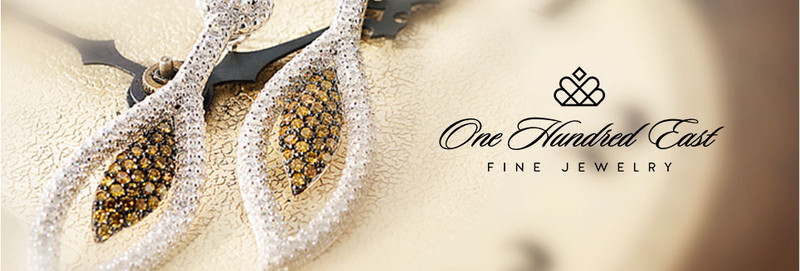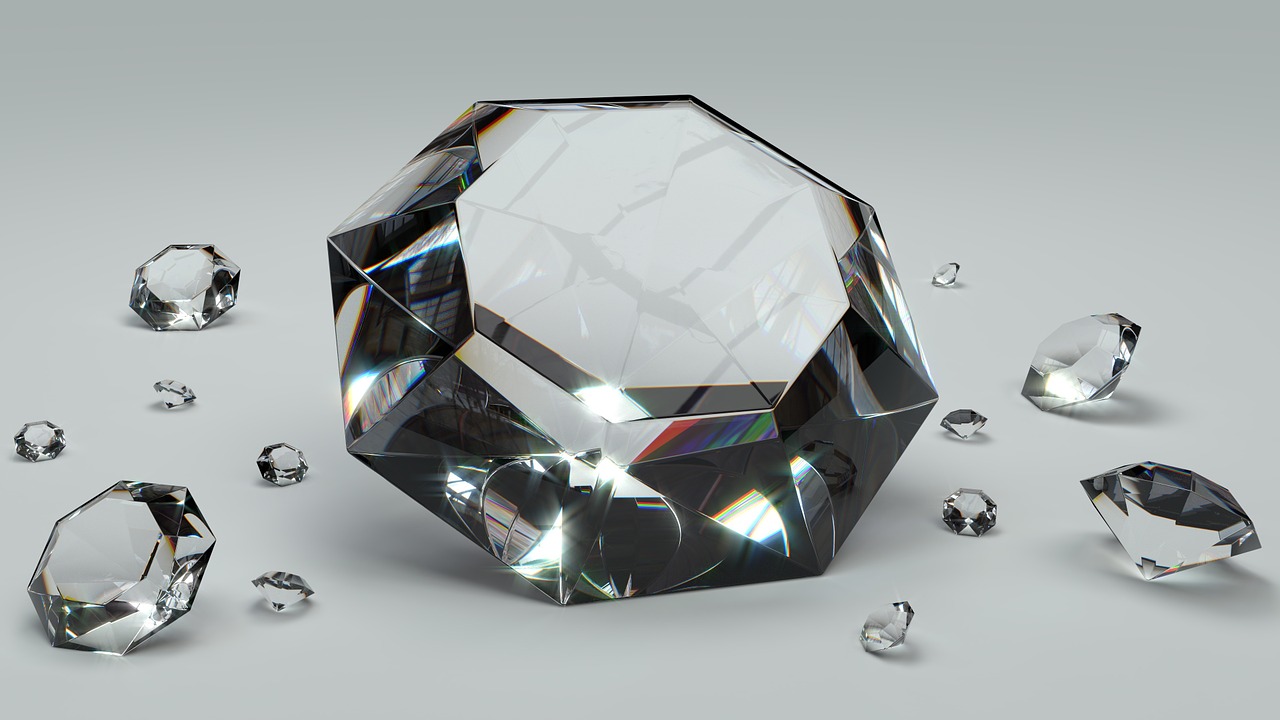
April’s birthstone, diamond, has a long history as one of the world’s most sought-after and treasured gemstones. Formed entirely from carbon, it’s the only gemstone consisting of a single element. It’s also the hardest material on earth, 58 times harder than anything else in nature. Diamond can be cut only by another diamond.
Its durability has been known and admired for centuries. Its very name is derived from the ancient Greek word ‘adamas’ which translates to ‘invincible’, ‘unconquerable’ or ‘unbreakable’. Diamond is cherished for its colorless nature, purity, internal fire and clarity. Best known for its lack of body color, diamond also forms in a wide range of colors such as white, black, blue, green, pink, red, purple, orange and yellow. You can learn about fancy colored diamonds in our blog What Are Colored Diamonds & How Are They Evaluated.
The diamond engagement ring is considered a near-universal symbol of love and marriage. Besides being April’s birthstone, diamond also marks the 60th and 75th wedding anniversaries. if you're interested in learning about the diamonds we us in our 100 East Fine Jewelry products, you can find the information in the About section of our website.
Stages of a Diamond’s Life
Diamond has a well-deserved reputation for being the ultimate symbol of endless and enduring love. Few journeys are more ‘endless and enduring’ than that of a natural diamond when making its way to you or your loved one.
A natural diamond’s journey began between 1 and 3 billion years ago. At that time, carbon was subjected to the immense pressure and temperature (around 2000 degrees F) of being buried 90 to 120 miles beneath the earth’s surface. Those extreme conditions caused the carbon atoms to bond in a unique way which resulted in diamond’s beautiful crystalline structure.
If diamonds form around 100 miles beneath the earth’s surface, how do we get to them, when the deepest man-made hole in the earth is 7 ½ miles deep? That’s the next part of diamond’s formidable journey, or maybe it’s better to call it an earth shattering journey. Diamonds are brought to the earth’s crust by way of volcanic activity. Centuries later, either man or nature frees it from the earth so it can be cut and polished to expose its unparalleled brilliance and internal fire. It can then be placed in a piece of jewelry to be treasured and admired for generations to come.
The History of Diamond
Diamond has a very long history, dating back to 4th century BC India, where crystals were first discovered in rivers and streams. Those ‘river rocks’ became a source of trade as diamond rose in status as beautiful objects of desire. Eventually, they could only be owned by royalty and the very wealthy.
Large numbers of these stones were also transported from India along the network of trade routes connected to China, commonly known as the Silk Road. In the first century AD, Roman naturalist and author, Pliny the Elder wrote: “Diamond is the most valuable, not only of precious stones, but of all things in this world.” Ancient Hindus used diamonds as eyes in devotional statues. Later, caravans brought Indian diamonds and other exotic goods to medieval markets in Venice.
By the 13th century, small numbers of diamonds began appearing in European regalia and jewelry. France’s Louis IX decreed diamonds be reserved solely for the king. By the late 14th century, diamond cutting is believed to have started in Venice, with early cutters using boards treated with olive oil and diamond dust to shape diamonds.
During the 15th century, diamonds were becoming fashionable accessories among Europe’s elite. The first diamond engagement ring on record was given by Archduke Maximillian of Austria to his betrothed in 1477. By the 16th century, thanks to the development of diamond faceting, which greatly enhanced their appeal, diamonds were becoming larger and more prominent, showing up in royal jewelry.
By the early 1700s, India’s diamond supplies began to decline. In 1725, Brazilian gold miners discovered diamonds, which started Brazil’s emergence as an important supply source. Brazil went on to dominate the diamond market for more than 150 years, even though the supply was not sufficient to meet world demand.
While sources were changing from India to Brazil, the diamond market experienced a revolution of its own. By the late 1700’s, the biggest diamond consumers, the old ruling classes, were in decline. Political upheavals like the French Revolution led to changes in the distribution of wealth. The 1800s brought increasing affluence to west Europe and the United States; further broadening diamond demand when a major expansion of supply was discovered.
In 1866, a 15-year-old South African boy came across what he thought was an ordinary pebble along a river bank. That pebble turned out to be a 21.25-carat diamond. This, and other findings, sparked a rush of thousands of diamond prospectors to the area, leading to the opening of the first large-scale South African mining operation. This new source substantially increased the world’s diamond supply. The elite no longer considered diamond a rarity and began replacing it with colored gemstones, such as emerald, ruby, and sapphire.
The South Africa diamond discovery marked the beginning of the modern diamond industry. Entrepreneur Cecil Rhodes established De Beers Consolidated Mines Limited in 1888. By 1900 De Beers controlled around 90% of the world’s rough diamond production. The largest diamond ever found, at 3,106 carats, was recovered from a South African mine in 1905. It was cut into 105 individual gemstones, including the Cullinan I and II.
For approximately 2000 years, from roughly 400 BC until the early 1700’s, India was the only significant source of diamonds. Over the next 175 years or so, until the turn of the 20th century, only two additional major diamond sources were discovered and active; Brazil and South Africa. Despite diamond being revered for centuries, little scientific knowledge about it existed before the 20th century. Since then, scientific and technological understanding of diamond formation, discovery, mining and manufacturing has grown steadily thanks to research by chemists, physicists, geologists, mineralogists, and oceanographers. In the past 50 years alone, scientists have learned a lot about how diamonds are formed and transported to the earth’s surface. That knowledge has made it easier to predict locations for new diamond discoveries, greatly expanding global output in the 20th and 21st centuries.
Today, diamond mining has grown to about 25 countries, located on every continent except Europe and Antarctica. Diamonds are a world-wide resource, with production of diamond rough now dominated by Australia, Botswana, Russia and the Democratic Republic of the Congo and South Africa remaining a major producer.
Diamond Lore
After their discovery in the 4th century BC, a common belief developed that diamonds possessed magical powers. Worn as a talisman to ward off evil, they were regarded to provide protection during battle. Ancient Greeks and Romans believed diamonds were tears cried by the gods or splinters from falling stars. The Romans also believed Cupid’s arrows were tipped with diamonds, perhaps creating the earliest association between diamonds and romantic love.
An anonymous second-century poet maintained diamond warded off the evil eye – a malevolent look believed to cause sickness, poverty and even death. In the Dark Ages, diamonds were used as a medical aid and were thought to cure illness and heal wounds when ingested. During the Middle Ages, their healing powers encompassed a cure for ailments of the pituitary gland and brain.
Over subsequent centuries, diamond was thought to be an antidote to poison and provided protection against the plague. Some claimed it granted longevity, strength, beauty and happiness. Heating a diamond crystal and taking it to bed was regarded as a means to remove toxins that crippled the body. Diamond was also believed to improve an individual’s balance and clarity and when combined with other crystals, such as amethyst, could boost their energy. Diamonds was thought to inspire loyalty, rouse romance and encourage a joyful life
Famous Diamonds
A few of the most famous diamonds include:
- The 45.52 carat, rare, blue-colored Hope Diamond, on permanent display in the Smithsonian, is one of the most famous jewels in the world. Recent evidence supports the origin of the legendary diamond in India, with ownership records indicating King Louis XIV of France purchased the Hope in 1668.
- Cullinan I or the Great Star of Africa, at 530.4 carats is the largest clear cut diamond in the world. Cullinan I, part of the Crown jewels and housed in the Tower of London, is mounted in the head of the Sovereign’s Sceptre with Cross.
- The Cullinan II, the Second Star of Africa; a 317.4 carat rectangular cushion cut, is set into the Imperial State Crown; also part of the Crown Jewels.
- The Orlov was said to have been pried from the eye of an idol in India in the 1700s by a deserter from the French army.
- The 245.35-carat Jubilee Diamond, discovered in the Jagersfontein Mine in 1895, is part of the Mouawad diamond collection.
- Elizabeth Taylor owned the 69.42-carat Taylor-Burton Diamond from 1969 to 1979.
Diamond Use in Today’s Jewelry
Diamonds continue to dominate global gemstone sales. Worldwide polished diamond gemstone sales were estimated at $26.7 billion in 2019, with global diamond jewelry sales estimated at $79 billion. Because of their durability and luster, diamonds are particularly well suited for use in fine jewelry, especially rings and bracelets which are prone to banging and bumping against hard objects. Diamond remains the top selling gemstone for bridal jewelry. Round cut is the number one selling shape from among the 10 or so standard cuts.
While diamond is best known for its use in jewelry, only around 30% of all mined diamond crystals possess the characteristics necessary to be considered for gemstone manufacture. The remaining ~70% of rough diamond crystals are used for industrial purposes, most commonly as drill tips and abrasives. They are extremely effective at drilling, cutting, grinding and polishing other materials. Since diamond can only be cut by another diamond, tools containing diamond dust are used in the manufacture of jewelry-grade gemstones.
In recent years, a new market for diamonds has developed in the phenomenon of diamond beauty products. A number of beauty companies began offering products, such as body sprays, containing diamond dust.
Diamond Color Characteristics
When most people think of diamonds, they picture a sparkling gemstone as clear as ice. In actuality, the vast majority of diamonds graded as colorless possess a small amount of color, usually yellow or brown. The Gemological Institute of America refers to these colorless to lightly tinted yellow or brown diamonds as falling in the Normal Color Range. GIA created a universally accepted scale for evaluating Normal Color Range Diamonds, which we cover in our blog The 4 C’s of GIA’s Diamond Grading. The 4C’s serve the dual purposes of providing a common language to communicate a diamond’s quality as well as a means to compare diamonds. Diamonds evaluated on the Normal Color Range scale are valued more for their relative absence of color. All other factors being equal, the less color in a Normal Color Range diamond, the more valuable it is.
Formation, Mining and Cutting
A brief overview of diamond formation can be found above in the “Stages of a Diamond’s Life” section. A diamond’s crystal structure consists of regular, repeating patterns of atoms. The ideal form for a diamond crystal is an octahedron. Containing 8 equal triangular sides, it looks like two 4 sided pyramids joined base to base.
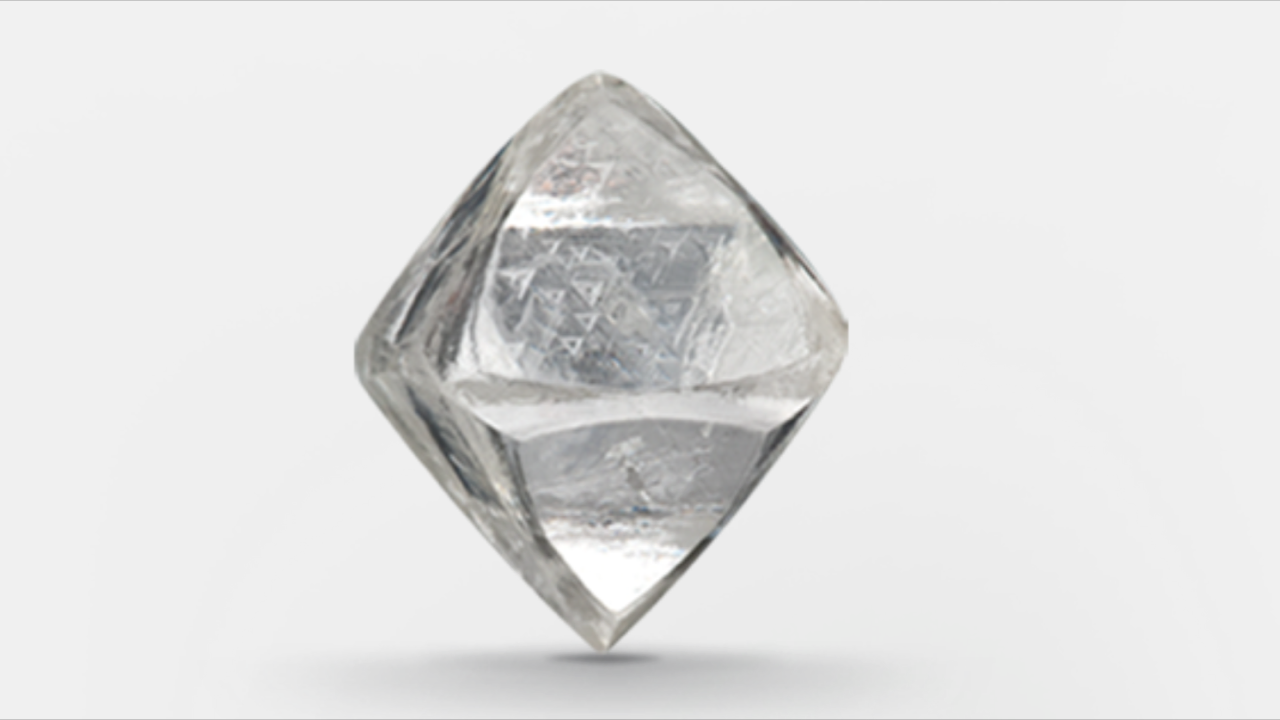
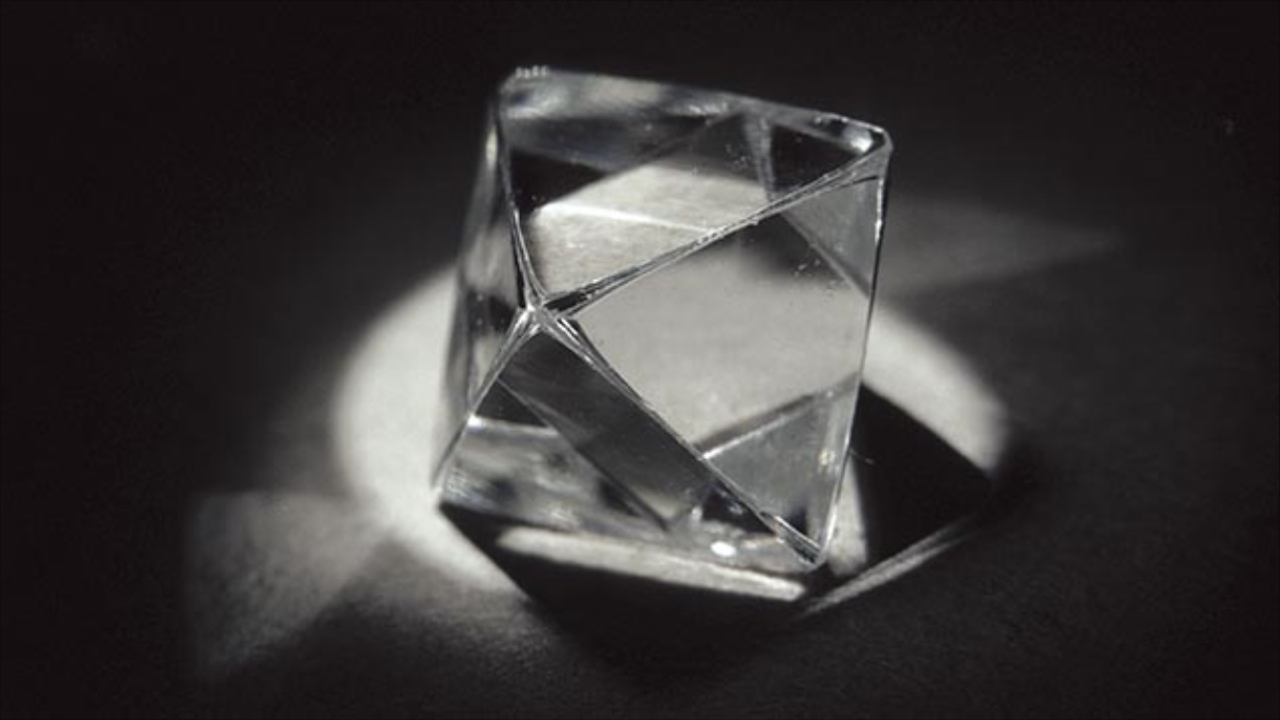
Perfectly shaped octahedron diamond crystals are so rare they often end up as collector’s items and are never cut. Rough diamond crystals are found in a variety of shapes. They can be perfectly symmetrical or crooked and deformed.
After a volcanic action brings diamond crystals to the earth’s surface, they are later found in either the rocks that carried them to the surface (primary deposits) or in secondary locations far away from the original site. This occurs when erosion wears away the rock containing the crystals, scattering the now freed crystals by floods, rivers and streams (secondary deposits). Accordingly, diamond mining occurs in one of the following methods:
- Primary deposit mining involves open pit mining and/or underground mining. These occur when the diamonds are still in embedded in the rock which brought them to the surface. A primary deposit mine can be an open pit or an underground mine or start out as an open pit and then convert to underground. Open pit mining involves large surface excavation. Eventually the pit reaches a depth where it’s impossible to operate as an open pit mine any longer. At that point, the mine can be closed or converted to underground.
- Secondary deposit mining, also known as alluvial mining, is needed when erosion has broken the diamonds free from the rocks. Rains and floods carried the crystals to rivers, where they remain. In these situations, the diamonds can be found in and around the streams and rivers, as well as dried up stream and river beds. Alluvial mining is conceptually similar to that of old-time gold miners, involving picks, shovels, sieves and pans. However, today’s alluvial mining is on a much larger and mechanized basis.
- Marine mining is another form of secondary deposit mining, except in this case, once the diamonds reach the rivers, they are carried all the way to an ocean. Ocean currents carry them along the shore, dispersing them over large areas of ocean bottom. The diamonds might collect along the shores or be carried out to deeper water. Namibia is well known for shore mining. Offshore mining can be performed by divers down to a certain depth. In deeper water, specially outfitted ships are used.
Diamond crystals leaving the mines, known as rough material, is first sorted into gem quality or industrial grade. Gem grade material is further categorized based on evaluation of size, shape, clarity and color. From the mines, diamond rough goes to a cutting center. India cuts by far the vast majority of the world’s diamonds, approximately 90% by volume. India reportedly employs over a million workers in diamond manufacturing, much of it in Surat. Other major cutting centers are Antwerp Belgium, Tel Aviv, Israel, New York City, Thailand and China.
For decades, diamond cutting and polishing were performed by hand. Today’s diamond cutting and polishing processes rely on computers to aid in planning the diamond crystal’s cut in order to optimize quality and profit. Cutting the crystal is conceptually the same process whether done by hand or machine. However, today’s use of rotary saws and lasers are much more efficient than hand cutting. Likewise, today’s automated polishing machines dramatically reduces the labor needed to perform the polishing process. Today’s hi-tech manufacturing processes not only improve efficiency but also provides a more consistent quality gemstone.
Kimberley process is an industry program designed to ensure that diamonds crossing international borders are legitimate and do not fund civil conflict or terrorism.
Diamond Treatments
A relatively small percentage of gem-quality diamonds are treated for two reasons: to improve clarity or to alter color. Scientists began looking for ways to enhance a diamond’s appearance at the turn of the 20th century and got more aggressive after WWII. Technological advances have resulted in more sophisticated diamond clarity and color treatments. Some modern treatments, though, have a significant drawback: they improve a diamond’s appearance, but may not be permanent.
Techniques used to modify a diamond’s color, include:
- Irradiating – Natural green diamonds obtain their color by way of natural radiation in the ground. Laboratory research determined that green and blue diamonds can be created by irradiating light yellow and brown material. Lab irradiation is so similar to natural that it’s almost impossible to separate natural from lab irradiated diamonds. A word of caution, if irradiated diamonds are later subjected to heat, for example during a jewelry repair process, the diamond’s color can change.
- Annealing – Annealing uses controlled heating and cooling to modify a diamond’s color. When used in conjunction with irradiation, green and blue diamonds can be modified to create fancy yellow, orange, purple or pink colors. The same caution about changing the color of the diamond during jewelry repair applies.
- Heat and pressure – The same technique used to create synthetic diamonds can be used to modify brown tinted diamonds. Some brownish diamonds can be made almost colorless, while others can be changed to yellow or green diamonds. The process also increases the treated diamond’s value.
- Coatings – one of the oldest known means of modifying gemstone color is applying a coating of colored material to the gemstone. While this process was quite crude many years ago, new technology has improved the appearance and durability of the coatings. Diamonds from the Normal Color Range scale are coated to create a number of natural-looking fancy colors, including pinks, oranges, yellows, blues and violets. The coating is not permanent and can be scratched, worn off or damaged by heat.
Techniques used to modify clarity of a diamond include:
- Fracture filling – This is the most common diamond treatment. Often, diamonds contain surface-reaching fractures, known as feathers, which might make a diamond unattractive for use in jewelry. Lead-based glass is used to fill in these feathers, making it almost impossible to see with the naked eye. The treatment is not considered stable, but if properly cared for, the glass filling can last for years. Disclosing fracture filling to a purchaser is an industry requirement.
- Laser drilling – Lasers are used drill tiny tunnels, thinner than a human hair, to reach a dark inclusion in the body of the diamond. The inclusion can then be made less noticeable by laser-vaporizing, etching with acid or bleaching. This treatment is considered stable. Since laser holes are permanent, they are identified in laboratory gem reports and taken into account in the clarity grade.
At 100 East Fine Jewelry, we do not use treated diamonds, other than black diamonds, which are routinely treated with either heat or radiation to achieve the black color. We disclose all treatments on all our gemstones.
Laboratory Grown Diamonds
To simplify the topic, here’s a straightforward question and equally straightforward answer:
Question: Are lab grown diamonds real?
Answer: Yes. They’re physically and chemically identical to mined diamonds.
Many of you probably don’t need to read any further. Laboratory-grown and natural diamonds possess essentially the same chemical, physical, and optical properties. They’re the same product; they’re just created in a factory instead of underground. Man-made diamonds have gone by many different names since they were first introduced by General Electric Company in 1954. To ease confusion, the US Federal Trade Commission recently established guidelines specifying that only a natural, mined gemstone can use the word diamond in a stand-alone manner. Specific terms they allow to represent laboratory grown diamonds must clearly and conspicuously disclose they’re not a mined stones. ‘Laboratory-created’, ‘Laboratory-grown’ and ‘[manufacturer name]-created’ are acceptable ways to identify laboratory grown diamonds. No longer are such terms as ‘synthetic’, ‘cultured’, ‘man made’ and ‘real’ allowed.
Creating gemstones in a laboratory or factory is not a new concept. Many colored gemstones, such as amethyst and sapphire, have had lab-created options for decades. Diamond’s unique beauty, rarity and value have aroused attempts to create them from pure carbon since the 1700’s. Prior to the 1950’s, all attempts to create diamonds failed due to a lack of the technology necessary to achieve temperatures and pressures required to form its crystals. Below is one of the early pieces of equipment used to create man-made diamonds, which I saw on display at GIA’s Carlsbad facility.
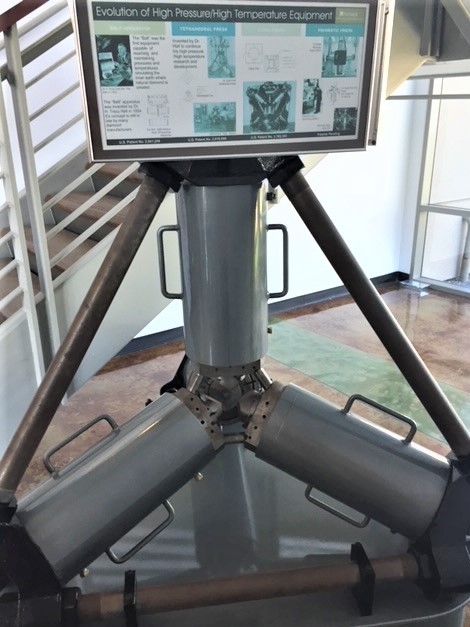
Since the first lab-made diamond was created, the industry has grown by leaps and bounds. Like natural diamond, a significant percentage (90%) of lab-grown goes to industrial use. In fact, synthetics are preferred for industrial use because they’ve proven superior to mined diamonds due to less variability in their quality.
Jewelry made with lab-created diamonds began hitting the market in meaningful quantities about a decade ago. In the past 5 years, they’ve continued to rise in popularity. In 2019 less than 2% of the global jewelry sale contained lab-grown diamonds. Future projections vary, but the growth rate of lab-grown is expected to increase at an increasing rate. One forecast predicts by 2023 lab-grown diamond jewelry is expected to grow to around 2.5% and to about 3% by 2035. Another report forecasted global sales to reach 10% of the market by 2030.
Consumer interest in lab-grown diamonds for use in jewelry originally appeared to be driven by ethical, sustainability and environmental issues. Specifically, stopping the trade in ‘blood diamonds’ to fund an insurgency or warlord’s activity, reducing the ravages of mining on the landscape and reducing carbon emissions to improve the environment. These non-cost factors seem to be lessening as driving forces of consumer acceptance of lab-grown. While not perfect, the Kimberley process, which was introduced in 2003, has been effective in reducing the flow of conflict diamonds. There has been absolutely no slow-down in mining natural diamonds since the introduction of laboratory-grown diamond, and none is anticipated. It appears there will always be a market for natural diamonds. Some studies suggest that lab grown diamonds may actually take up a larger carbon footprint than mined diamonds. One report indicated lab-grown diamonds emit more than 3 times the CO2 per carat than does a mined diamond.
It appears today’s attraction to lab created diamonds is really about cost. They are simply sold at a lower price than natural diamonds. The cost of lab-grown diamonds is currently about 30% lower than natural for a similar size and quality stone. However, the lab-grown market is still relatively new and pricing unstable.
While consumer acceptance of lab-grown diamonds continues to increase, I personally don’t use them. I’m not against them, but I feel there will always be a strong market for natural diamond jewelry. Diligent enforcement of the Kimberley Process will continue to reduce the flow of conflict diamonds. A certain romantic aura is associated with an item that is 1 to 3 billion years old. Diamond miners and factories creating man-made diamonds will both be challenged to become more environmentally friendly.
Diamond Simulants
As far back as the 1700’s, diamond has inspired the creation of a wide variety of less expensive, look-alike products. These imitations, called simulants, should not be confused with synthetics, which are real diamonds, just grown in a factory instead of naturally in the ground. Some diamond simulants are created legitimately to make attractive costume jewelry for people who want the look of fashionable jewelry without the high cost. Unfortunately, some simulants are created with the intent to defraud others. Diamond simulants can be made from either natural or manufactured materials.
While early simulants were not very sophisticated, they can still be found in antique and estate jewelry. Those early imitations include:
- Glass and rhinestones – colorless lead-glass used alone or sometimes backed with foil.
- Doublets – a simulant made of garnet and glass. The eye-visible, upper part of the stone is garnet, which is glued to the bottom, which was made from glass.
- Other clear gemstones, such as zircon and sapphire.
Beginning in the second half of the 20th century, simulants began being grown in labs and were much more convincing diamond look-alikes. Some materials quickly faded away, but two remain popular, synthetic cubic zirconia and synthetic moissanite. The FTC has rules to protect the consumer against deception from selling simulants and synthetics as diamonds. However, that doesn’t prevent unscrupulous people from attempting to defraud. When buying diamonds, it’s best to seek out reliable and knowledgeable jewelers and gemologists for expert advice.
Most 100 East Fine Jewelry pieces contain diamonds along with other colored gemstones. If you’re looking for a gift for that special someone born in April that is made with nothing but diamonds, click the link to browse the current 100 East Fine Jewelry Diamond Collection.
Credit to American Gem Trade Association, Gemological Institute of America and Gemworld

